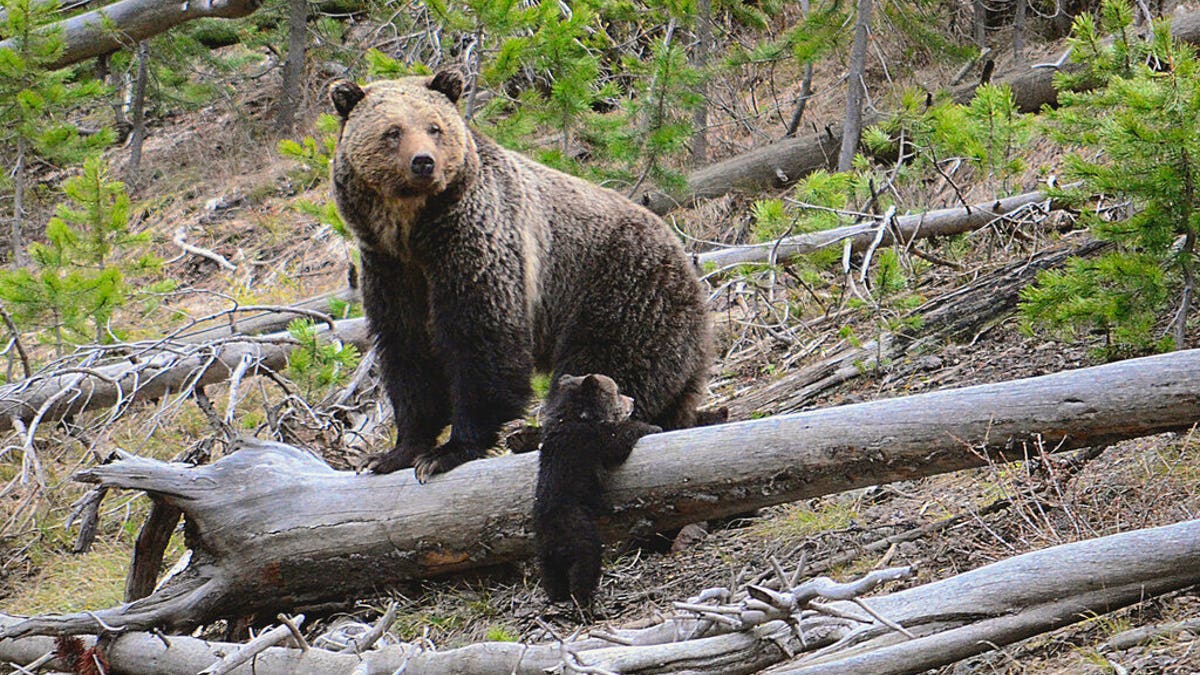
This April 29, 2019 photo provided by the United States Geological Survey shows a grizzly bear and a cub along the Gibbon River in Yellowstone National Park, Wyo. Wildlife officials say grizzly bear numbers are holding steady in the Northern Rockies as plans to hunt the animals in two states remain tied up in a legal dispute. (Frank van Manen/The United States Geological Survey via AP)
Grizzly bears are expanding their range in the U.S. Northern Rockies, spreading from remote wilderness into farmland amid a legal fight over proposed hunting.
New government data from grizzly population monitoring show bruins in the Yellowstone region of Montana, Wyoming and Idaho expanded their range by about 1,500 square miles (3,900 square kilometers) over the past two years.
They now occupy almost 27,000 square miles (69,000 square kilometers), a range that has grown 34 percent in the past decade.
That means more bears on private lands where they can encounter humans and attack livestock, said Frank van Manen with the U.S. Geological Survey.
Run-ins with bears are happening in agricultural areas where the fearsome animals hadn't been seen for decades, raising tensions in communities over the grizzly's status as a federally protected species in the U.S. outside Alaska
PROTECTIONS RESTORED FOR GRIZZLIES; HUNTS BLOCKED
"Not all grizzly bears are livestock killers, but of course it only takes a few to do potentially quite a bit of killing," van Manen said.
Wyoming and Idaho officials proposed grizzly hunts last year, but they were blocked by a judge's ruling.
Government attorneys on Friday asked an appeals court to overturn part of that ruling. The case could take months or even years to decide, even as there's no end in sight to the trend of bears getting into more conflicts at the periphery of their range.
An estimated 700 bears live in the Yellowstone area. Biologists say that's a conservative figure and doesn't include grizzlies that are outside a designated monitoring area that's centered on Yellowstone National Park.
The U.S. Fish and Wildlife Service contends the animals no longer need federal protection. State officials say hunting would give them a tool to better manage their numbers, but that it would be limited to sustainable levels.
In his ruling that blocked hunting, U.S. District Judge Dana Christensen said in part that officials had not given enough consideration to how lifting protections for Yellowstone bears would affect other grizzly populations in the Rockies.
CLICK HERE FOR THE FOX NEWS APP
The government conceded that point in Friday's court brief, saying officials already had started working on the topic and would explain the impact that lifting protections would have on other bears.
But U.S. Justice Department attorneys pushed back against the judge's further contention that a "comprehensive review of the entire listed species" was needed. That would require officials to look more closely at the status of other bear populations, beyond the impacts of a decision to lift protections around Yellowstone.
The attorneys said such a detailed review exceeds what's required under federal law.
Environmentalists argue that it's too soon to lift protections first imposed in 1975, especially because conflicts between humans and bears remain a prime cause of bear deaths. Also, Yellowstone bears are isolated from other populations, which has raised questions about their long-term genetic health.
"For us it's never been a numbers game," said Andrea Santarsiere with the Center for Biological Diversity. "For grizzly bears to really be recovered, we need to see those populations connected."
A coalition of American Indian tribes wants Congress to protect grizzlies permanently. They say the animals are sacred and play a role in many ceremonies and traditions.
Yellowstone became a refuge for the species last century after hunting and trapping killed off bears across most of their range.
The park remains a grizzly stronghold. But younger, male bears search for territory of their own outside the park, with females soon following behind, van Manen said.
A similar dynamic has played out in Northwestern Montana, home of more than 1,000 grizzlies. The area includes Glacier National Park and the vast Bob Marshall Wilderness.
Bears in recent years have attacked livestock dozens of miles outside those wild areas, on the open plains of central Montana where ranches and cropland occupy the landscape.






















